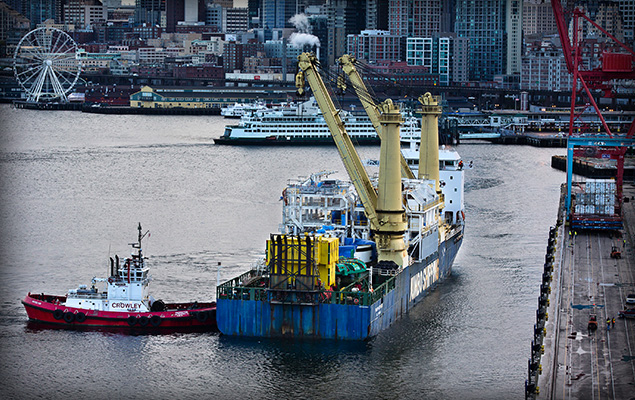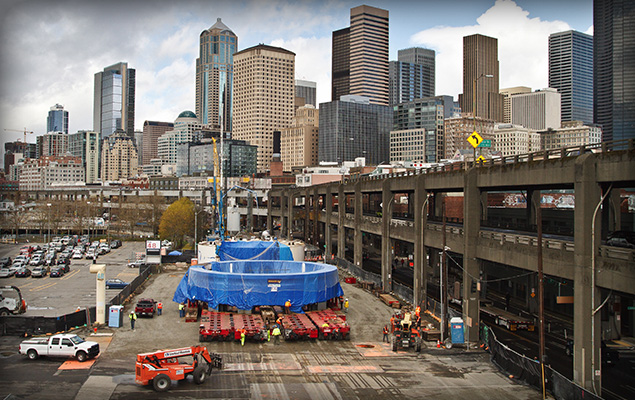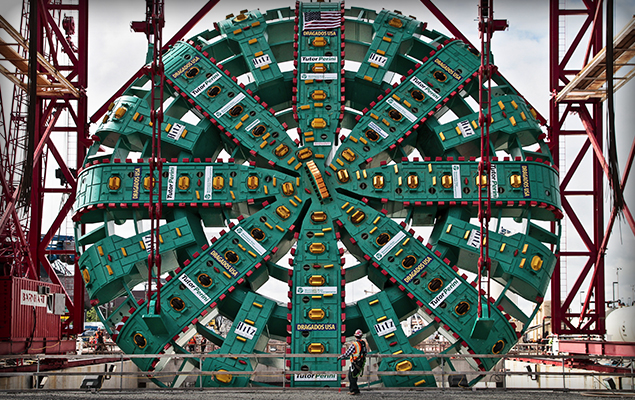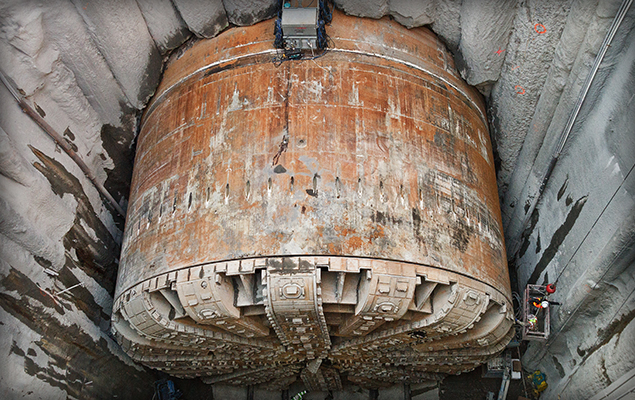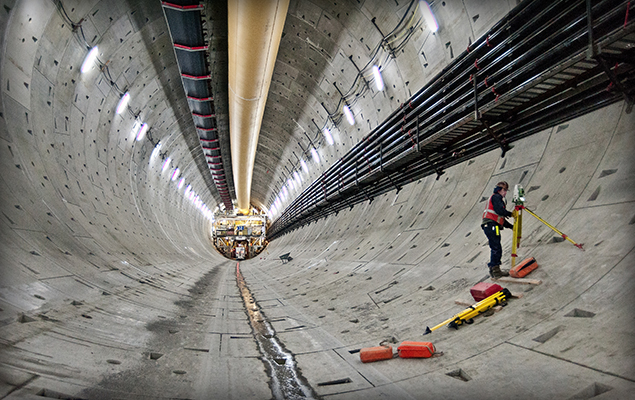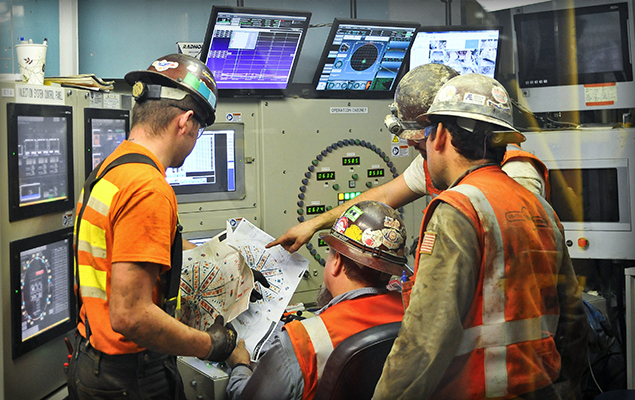Year: 2015
Optimizing Soft Ground Excavation: Development and Design of EPB and Slurry Cutterheads
The history and development of soft ground tunnelling machines is a long one, and one in which the quest for optimal design to achieve safe and efficient excavation has always been a top priority. Modern soft ground tunnelling began with the introduction of Slurry TBM technology in 1967 and the development of Earth Pressure Balance (EPB) machines a bit later in 1974 in Japan. Many advances have since been made by Japanese manufacturers, as well as North American and European manufacturers. These advances were the result of lessons learned from the successes and failures of the technologies in a variety of geologies. In many cases the philosophies of Japanese and European manufacturers were quite different, resulting in unique machine features. In the case of both EPB and Slurry, many of these advances have involved the development of the cutterhead, which is the first part of the machine to come in contact with the soil. Cutterhead design is not only integral to operation of the TBM, but also to machine performance. Proper cutterhead design must incorporate a variety of project variables including expected geology and operation of the machine. To appropriately specify and evaluate soft ground cutterhead features, there must be an appreciation of how these features developed and how this applies to a job-specific geology.
This paper will review the fundamentals of cutterhead design and how particular attributes interact with the geology and other machine features to achieve efficient excavation. When possible, comparisons between EPB and Slurry technology will be addressed. Comparisons will also be made between the varying schools of thought in terms of soft ground machine design in both Europe and Japan. In addition, the features will be evaluated for potential outcomes with differing geologies and methods of operation. A thorough understanding of these items allows for an educated approach to maximization of machine advance and performance.
Unique Hybrid EPB Design for use in Coal Mine Drifts
The Grosvenor Decline Tunnel is an ASD $1.95 billion Greenfield metallurgical coal project owned by Anglo American in Moranbah, Central Queensland, approximately 180 kilometers southwest of the coastal port city of Mackay and about 1000 kilometers north of Brisbane. Located just south of the Moranbah North coal mine, it targets the same Gonyella Middle coal seam as the Moranbah mine, and it is expected to produce five million tonnes of coal per annum from its underground long wall operation over the next 26 years.
The Grosvenor Coal Mine has a planned expansion in which two decline tunnels will be required for mine access to the coal seam at the shallowest depth of 130 meters. Longwall panels are planned to be 300 meters in width with lengths up to 6200 meters. The first decline tunnel (Conveyor Drift) will transport the coal from the long wall to the stockpiles area on the surface; the second decline tunnel (Transport Drift) is designed for people and equipment to access the underground once the mine is operational.
For the first time in the Queensland coal industry, a TBM methodology has been developed to ex-cavate both drifts and contribute to construction of the “world-class long wall mine” envisioned by Anglo American. Stability, safety, quality and schedule have been the key factors in the selection of this technology.
Rescue and Refurbishment of a TBM inundated with Flood Waters at the New York City Harbor Siphon Project
In October 2012, New York City’s Harbor Siphons Project and its 3.6 m CAT EPB ground to a halt when hit by Superstorm Sandy. Despite contractor Tully/OHL JV’s best efforts to mitigate anticipated flood risks, the launch shaft was inundated with seawater, flooding the tunnel and TBM just 460 m into the 2.9 km long drive. A team of Robbins and OHL personnel were able to document, reverse engineer, and refurbish severely corroded components of the TBM while in the tunnel, resulting in a successful re-launch in April 2014. This paper will document the incredible efforts of the team to rescue and refurbish the TBM, and its performance since the restart.
Dual Mode, “Crossover” Type Tunnel Boring Machines: A Unique Solution for Mixed Ground in the Middle East
While both Hard Rock Tunnel Boring Machines (TBMs) and Earth Pressure Balance (EPB) machines have been in existence for 50 years or more, the prevalence of mixed ground tunnels can make their use problematic. In many tunnels with both sections of hard rock and softer EPB type ground, the only historical solution was to use multiple machines or sacrifice efficiency by using just one machine type. Today, Dual Mode, “Crossover” type machines are edging TBMs into new territory by employing design elements from both EPB and Hard Rock Single Shield Machines. Where multiple machine types might have once been used, a Crossover Rock/EPB machine can excavate an entire tunnel in vastly different conditions. The machine type is particularly useful in fractured and faulted weak rock where clay inseams and sections of soft ground may be present. New designs are making this versatile take on tunnelling more efficient, even at larger diameters of 12 meters or more. This paper will explore modern trends in mixed ground TBM tunnelling, including Crossover EPB/Rock Designs that could be applied to the weak/soft rock so often encountered in Middle East tunnelling. It will also look at other Crossover machines being introduced into the industry, including Crossover EPB/Slurry TBMs for tunnelling in high pressure conditions.
Beyond Boring: A Journalist's Fascination with Tunnelling
About the Guest Author: Roland Herr has a background in civil engineering and is an international freelancing journalist. He has over 20 years of experience on engineering and construction projects all over the world, and is especially interested in tunneling.
Those working in tunnelling understand that this is an industry more fascinating than any other. What is it about tunnelling that makes it so exciting to those in the field?
Curious to know more, I discussed this question with some very experienced European tunnelling specialists: Frode Nilsen (Norway), Managing Director of LNS, and Dr.-techn. Klaus Rieker (Germany), Managing Director Tunnelling Division of Wayss & Freytag Ingenieurbau AG. Both conversations took place at different places and times, but with strikingly similar results.
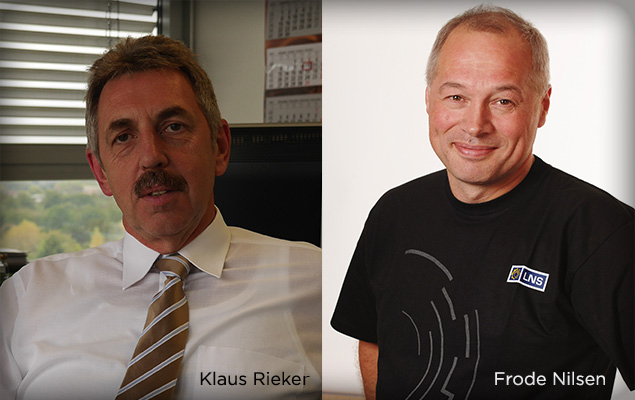
Dr.-techn. Klaus Rieker and Frode Nilsen took time to share their experiences in the tunnelling industry.
Frode and Klaus both have extensive backgrounds in the underground industry. Frode has been working with tunnels since he left university, the Norwegian Institute of Technology, in 1988, and Klaus has been building tunnels for 25 years. Comparatively, I am a “youngster” with 14 years of experience with tunnels and the tunnelling industry, but no less enthusiastic.
Read on for the results of my Q&A sessions with Frode and Klaus:
One characteristic shared by most tunnellers is that they work internationally, on many different projects with varying levels of responsibility. Tell me about your international experience.
Klaus: [At Wayss & Freytag] I was assigned to different projects in Singapore, Malaysia and Taiwan. As a young engineer working in Asia, it was very hard to gain acceptance, particularly because in the Asian culture, older people are typically responsible for project management. It was difficult to convince the contractor that I could handle it, but step-by-step I proved myself with my performance and knowledge. I remember with pleasure my time on a metro project in Singapore; altogether we had about 30 nations involved on the project. It was really amazing!
Frode: Our most impressive project [at LNS] was SILA for the Iron Ore company LKAB. We blasted 12 silos out of the rock and built a 600 m long unloading hall and a 2.8 km tunnel for iron transport from the silos to the harbour. Our most famous project was the Svalbard Global Seed Vault in Spitsbergen for the UN, where we built tunnels and 3 rock caverns in the permafrost with an even temperature of -18° Celsius to store samples of the world’s seeds.
For Frode, the timeline and longevity of underground projects is also an amazing feat worthy of note—tunnels can be built in difficult ground conditions over a period of years, but the hard work pays off in that many tunnels have a design life of 100 years or more.
Working in tunnelling also provides a unique perspective on emerging markets. Which countries or markets are currently experiencing rapid development when it comes to tunnel construction?
Frode: In Europe, Norway is one of the most interesting nations, especially for drill & blast, with hard competition and low prices. In Asia, China is on top, and South America is also growing, in particular with the mining industry in Chile. Much of the future of tunnelling lies in mining: studies show that in 2034 around 60% of mining will be done in underground mines. That means tunnels for access, ore haulage, and more.
Klaus: Germany is now no longer really a market for tunnelling, and in Central Europe tunnel construction is declining. Meanwhile, Asia is the growing market. In Singapore for example, 10 to 20 machines are running annually for the metro system extension. China and India are also huge markets right now. I find North America to also be an interesting market with many current and upcoming projects.
Every industry has its own set of challenges. What do you find most challenging about working in the tunnelling industry specifically?
Klaus: A defining characteristic of tunnellers is that we love a challenge. We thrive on new, very difficult situations that demand utilization of all our knowledge and problem-solving skills, in order to find the best technical solution.
Frode: Client demands can be challenging, and are often accompanied by environmental and technical limitations as well as financial constraints.I am happiest when projects are profitable and everybody involved is satisfied.
Frode and Klaus’ comments on their experiences led me to one overarching conclusion: engineers working in tunnelling are some of the world’s brightest and most experienced, with shared passions for overcoming difficult situations and ever-expanding their world views. For adaptable and driven engineers, the tunnelling industry offers a challenging yet rewarding career with job security, as projects and new markets continue to emerge globally.
Robbins Main Beam TBM Boring Cycle
Video shows how a Robbins Main Beam, or open-type, tunnel boring machine (TBM) excavates tunnels in hard rock.
Rugged Robbins TBM and Conveyors go for Gold in Indianapolis
The News In Brief:
- The Robbins 6.2 m (20.2ft) diameter Main Beam TBM completed the Eagle Creek extension tunnel on March 5, 2015.
- The world-record-setting jobsite includes a number of unique aspects, the conveyor system being one of them. The Robbins continuous conveyor consists of 82,000 ft of belt and travels through two unprecedented 90-degree curves.
- The project was put in place to reduce the amount of raw sewage overflows in the city’s neighborhoods and clean up tributaries along the White River.
On March 5, 2015, a Robbins 6.2 m (20.2 ft) diameter Main Beam TBM finished boring a 2.8 km (9,175 ft) long extension tunnel, known as the Eagle Creek Tunnel, for the Indianapolis Deep Tunnel System in Indiana, USA. The contractor, Shea/Kiewit (S-K) JV, had much to celebrate: “I’m proud of our world records, and most of all our men and the hard work they have done as a team, working together to accomplish a project of this size,” explained Stuart Lipofsky, Project Manager, for S-K JV. “We finished the first 12.5 km (41,000 ft) [of the main tunnel] almost a year ahead of schedule. The extension added time but what is remarkable is that we were still able to finish within the original contractual dates,” continued Lipofsky. The completion of the first leg of a much larger tunnel system targets three critical CSOs that flow into the nearby White River, and will go online in 2017. The completed tunnels bring the city one step closer to achieving its consent decree with the U.S. Environmental Protection Agency (EPA), set to be achieved by 2025, to eliminate overflows into the city’s rivers.
The rebuilt Robbins hard rock TBM was first used on the 12.5 km (7.8 mi) long main tunnel, called the Deep Rock Tunnel Connector (DRTC). The new cutterhead arrived onsite in November 2012, and the machine was launched from a 76 m (250 ft) deep shaft to bore through limestone and dolomite. The TBM achieved world records in its size class of 6 to 7 m (20 to 23 ft), including “Most Feet Mined in One Day” (124.9 m/409.8 ft); “Most Feet Mined in One Week” (515.1 m/1,690 ft); and “Most Feet Mined in One Month” (1,754 m/5,755 ft). According to Tim Shutters, Construction Supervisor for project owner Citizens Energy Group, there were two main factors for the TBM’s high performance: “The first one is the very nice cutterhead provided by Robbins. It has performed very well. [Second], rock conditions are favorable for mining operations and optimal for fast production.”
Another important element that helped the speedy machine achieve a fast advance was, as Lipofsky put it, “one of the most complex continuous conveyor systems in North American tunneling construction.” The custom-built Robbins system, consisting of 25 km (82,000 ft) of belt, included horizontal and vertical conveyors for efficient muck removal. The system was the first built by Robbins to go through such sharp curves: “The belt is going through two 90-degree curves in opposite directions and S-curves in other places. It’s very unusual and amazing to see a belt system perform as well as this one did,” said Lipofsky.
Once complete, the deep tunnel project will reduce the amount of raw sewage overflows and clean up tributaries along the White River. Tim Shutters describes the environmental benefits the project will provide the Indianapolis community: “I’ve lived in Indy all of my life, and the White River has never been a focal point for the city as there is a lot of pollution. I really think that once it has been cleaned up, people will want to visit, they will swim and fish, and property values along that body of water will go up. Being able to finally utilize the river is key for us.”
After the early completion of the Eagle Creek Tunnel, the project will be moving into its next two tunneling phases. The White River Deep Tunnel will continue 8.5 km (5.3 mi) north of the completed DRTC and pump station. The Lower Pogues Run Deep Tunnel will split off 2.7 km (1.7 mi) from the White River Deep Tunnel heading east. Two additional tunnels, including Fall Creek and Pleasant Run, are anticipated to be built in 2020, and the project (27 km/17mi of tunnels in total) is expected to be fully completed by the end of 2025.
The Light at the End of the Tunnel: The Positive Side of Seattle’s SR99 Project
Seattle is the founding city of The Robbins Company, and a place where I lived for nearly 15 years and commuted on SR99 while working at Robbins early in my career. As such, the new SR99 Viaduct Replacement Tunnel Project is of great interest to me.
The industry is all too familiar with Seattle’s SR99 Tunnel and its TBM, known as “Big Bertha”. More specifically, much has been written with regards to the TBM needing repairs after about 300 m of boring. The TBM is the world’s current largest at 17.5 m in diameter, and is excavating a 2.7 km long drive.
TBM Tendering
Robbins was a relatively new entry into the EPB/soft ground tunneling business when tenders were called for the latest SR99 project in 2011, and we made a concerted effort to get the order for this particular TBM. We teamed up with Japanese TBM manufacturer Mitsubishi Heavy Industries (MHI) to get the order. Robbins has had an association with MHI for more than 20 years, with jointly-designed machines operating around the world on projects in India, China, the U.S., and more. MHI has built over 1,000 EPB machines and in my opinion, the Japanese TBM manufacturers are further advanced in EPB technology than their European and American counterparts.
Through the process of trying to receive this order, we learned a lot about the geology, as well as the contractors’ and TBM’s specification requirements. The contractor Dragados, one of the JV partners and very well-experienced in soft ground tunneling technology, developed a high-level specification for the TBM suppliers. All of the prospective TBM suppliers were required to quote and if successful, supply to this standard. We eventually stepped out of the tendering process to supply this TBM, as the lower prices and greater assumption of contract risk offered by our competitors made the TBM supply an impractical business option for us.
Tough Tunneling
The current situation at the SR99 project is more positive than media tend to paint it. The project design consultant did a commendable job on laying out the tunnel route and building in a contingency plan. Boring through glacial till, even with modern TBMs, is never an easy task as previous projects like the Brightwater Conveyance Tunnels have taught the city of Seattle. This is doubly so along the Seattle waterfront, which includes manmade fill, utilities, and buried refuse. In such ground, TBMs can encounter rapidly changing geology; pockets of groundwater; abrasive soil; and manmade objects such as unmapped disused pipes; foundation piles; etc.
Aware of the problems that can develop while using an EPB TBM in glacial till under a city with a lot of backfill, the SR99 designer wisely developed a contingency plan. The strategy, in addition to pre-planned safe havens, involved a “shake down” stretch of tunnel, which ran under no buildings. If problems did occur repairs to the TBM could be made by sinking a surface access shaft at this location. Unfortunately the need for that repair event occurred shortly after the machine commenced excavation.
Why there were failures of the cutterhead seals, and potentially the cutterhead main bearing, is yet to be determined. I doubt there will be any signs of failure of the main bearing when the crews get to inspect it. However, all parties involved are wisely taking precautions and installing a new main bearing in addition to the seals.
Bertha’s Lessons
The Seattle Tunnel Partners and WSDOT have in place a panel of experts to advise them on the highly technical details of the TBM design. I personally know several of these experts and they are well qualified to recommend and supervise the necessary repairs and procedures to get the TBM into a condition where it is able to finish this tunnel.
Having been in the TBM supply business for quite a few years, I unfortunately have to admit having been in a similar (fortunately not as well published) situation as the TBM supplier on more than one occasion. This situation–significant TBM problems at the beginning of boring—can result from many different factors and is not unique to the SR99 project. In fact, Robbins recently had a similar situation (admittedly on a smaller scale in terms of both public and financial impact) on a project in Turkey known as the Kargi HEPP. Despite extensive pre-planning, unexpected ground was encountered, which resulted in several in-tunnel stops and machine modifications in the first few hundred meters of the tunnel. What happens in these situations is you pull in the best minds with the most experience and immediately analyze the problem. The ultimate fix often ends up as a multi-level solution. You must ensure you have the problem under control, plus take additional measures to monitor the vulnerable components and operating procedures. At Kargi, this process resulted in the remainder of the project being finished without significant TBM problems. Without a doubt a similar process is going on at SR99 with Hitachi Zosen engineers, the contractor’s specialists, and the city’s board of experts.
Being one who is keenly interested in this project, I believe that this TBM will soon be back to boring with a new completion date, which will be fulfilled. I am optimistic that this project will one day be seen as a positive in the tunneling industry, where many lessons were learned and advancements were made. Such advancements will be put to use in Seattle and in other cities that greatly benefit from the excavation of more underground infrastructure.
Complimentary Webinar: A Myth Dispelled by President Lok Home
Subject: A Myth Dispelled: In Difficult Ground, the Time for Drill & Blast Excavation has Passed
Date: April 15, 2015
Time: 10:00 AM EST, 2:00 PM GMT, 2:00 PM WEST
Hosted By: Robbins
Register Now, Limited Spaces Available!
In the modern-day tunneling industry, one outdated perception remains: Traditional, tested methods are always the best. When presented with difficult ground””from fault zones to water inflows to mixed face conditions””many consultants and contractors rely on decades-old field studies and conclude that conventional excavation methods like drill and blast are the best option. With today’s Tunnel Boring Machine (TBM) technology, this assumption couldn’t be further from the truth. Modern TBMs are highly adaptable and capable of offering all of the same ground support and excavation capabilities of their conventional counterparts””most often with a safer setup and faster performance, not to mention at a lower overall cost.
In this complimentary 60-minute webinar, Robbins President Lok Home will analyze recent tunneling projects in difficult ground conditions where TBMs have proven their worth, including Turkey’s Kargi Kizilirmak Hydroelectric Project and Peru’s Olmos Trans-Andean Tunnel. At Kargi, a shielded hard rock TBM overcame incredibly difficult mixed face conditions with the help of in-tunnel machine modifications””ultimately completing the tunnel at an advance rate more than twice that of a drill and blast operation proceeding from the opposite end of the tunnel. At Olmos, the world’s second deepest civil works tunnel, a TBM ultimately succeeded at boring where drill and blast had failed: below 2,000 m of volatile volcanic rock in the Andes Mountains.
We invite you to submit your questions beforehand to marketing@robbinstbm.com to get a well-researched answer during the Q&A session at the end of the webinar.
Announcing the Crossover Series of Robbins Dual Mode TBMs
Robbins proudly announces its Crossover Series of TBMs, a line of field-tested, rugged Dual Mode-type machines. Crossover TBMs feature aspects of two TBM types, and are ideal for mixed ground conditions that might otherwise require multiple tunneling machines. The XRE (standing for Crossover Rock /EPB) is the most common type of hybrid machine, and features characteristics of Single Shield Hard Rock machines and EPBs for efficient excavation in mixed soils with rock.
An XRE TBM recently completed tunneling at Australia’s Grosvenor Decline Tunnel, where it excavated two mine access drives at rates fourteen times faster than a traditional roadheader. The latest drive was completed on February 9, 2015. “This was a big step forward for the mine to appropriately use civil tunneling technology for a mining application. I take my hat off to the management of owner Anglo American Coal to have the foresight and leadership ability to take this step. Using the Crossover technology [versus the traditionally-used roadheader method], the project was finished on schedule,” said Lok Home, Robbins President.
Additional types of Crossover machines include the XSE (Crossover between Slurry/EPB) and the XRS (Crossover between Rock/Slurry) TBMs. The Crossover series is quickly gaining in popularity, with Robbins Crossover TBMs currently being assembled in Mexico, Turkey, and Azerbaijan. An XRE TBM will begin excavation for Mexico’s Túnel Emisor Poniente II (TEP II) later this year, while an XSE is being readied for excavation at the Baku Metro.
The rebranding and Crossover terminology embodies the concept that the machines are able to cross over between modes, says Home. The unique machines are a top focus point for the company: “Robbins comes at this business with extensive rock experience so everything we design comes with the assumption that there will be tough conditions. When you have to “cross over” to another mode then already you are in difficult conditions, and contractors need robust machines to get through these challenges,” says Home.
Home foresees that machine sales will grow as more projects worldwide are planned in difficult and varying ground conditions. Survey results back up the trend, indicating an increased interest in Crossover-type machines worldwide. “This is a continuous evolution and we are consistently endeavoring to improve Crossover designs. We have three of the machines in production now and I see this number increasing year by year as the industry sees and accepts their value.”

 Close
Close  Menu
Menu 
